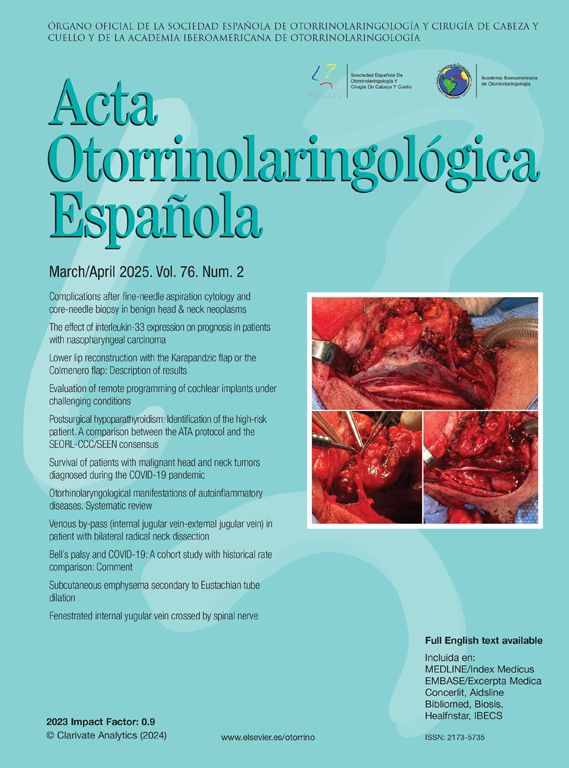Parathyroid hormone (PTH) levels are the most reliable parameter to identify patients with a high risk of post-thyroidectomy hypoparathyroidism. The American Thyroid Association (ATA) developed a consensus where postoperative iPTH (PTHpost) <15pg/mL suggests a significant risk for hypoparathyroidism. The Spanish Society of Otolaryngology and Head & Neck Surgery (SEORL-CCC) identifies high-risk patients as those with a decrease of preoperative-postoperative PTH levels (PTHdecr) ≥80%. A comparison of the accuracy of both protocols is made.
Materials and methodsAn analysis was conducted on all patients who underwent total or completion thyroidectomy over 10 years. A preoperative PTH (PTHpre) and a postoperative PTH (PTHpost) sample were collected. Postsurgical hypoparathyroidism was defined as the presence of hypocalcemia signs or symptoms, or calcium lower than 7mg/dL in serum levels or 0.95mmol/L in ionic levels. No patient received treatment without meeting our definition.
Results711 patients were included. 19% of patients suffered from hypoparathyroidism. The PTHdecr demonstrated a ROC curve with an AUC of 0.98. iPTHpost demonstrated a ROC curve with an AUC of 0.97. The PTHdecr was found to have a statistically superior AUC compared to the PTHpost (p=0.002). Considering cutoff levels of 80% for iPTHdecr and 15pg/mL for PTHpost, no statistical differences were found between the sensitivity of both protocols (93% and 95% respectively), but the same cutoff levels showed a superior specificity of PTHdecr (95%) than PTHpost (86%).
ConclusionsSEORL-CCC protocol, which relies on PTHdecr, has demonstrated superior diagnostic accuracy. The cutoff level used showed a superior specificity without sacrificing its sensitivity.
Los niveles de la hormona paratiroidea (PTH) son el parámetro más fiable para identificar a los pacientes con alto riesgo de hipoparatiroidismo post-tiroidectomía. La Asociación Americana de Tiroides (ATA) desarrolló un consenso donde se sugiere que una PTH postoperatoria (PTHpost) <15pg/mL indica un riesgo significativo de hipoparatiroidismo. El protocolo de la Sociedad Española de Otorrinolaringología y Cirugía de Cabeza y Cuello (SEORL-CCC), en colaboración con la Sociedad Española de Endocrinología y Nutrición (SEEN), identifica a los pacientes de alto riesgo como aquellos con una disminución de relativa de la PTH postoperatoria respecto a la preoperatoria (PTHdecr) ≥80%. Se realiza una comparación de la precisión de ambos protocolos.
Materiales y métodosSe realizó un análisis de todos los pacientes que se sometieron a tiroidectomía total o 2º tiempo de hemitiroidectomía durante 10 años. Se recogieron muestras de PTH preoperatoria (PTHpre) y de PTH postoperatoria (PTHpost). El hipoparatiroidismo postquirúrgico se definió como la presencia de signos o síntomas de hipocalcemia, o niveles de calcio inferiores a 7mg/dL en los niveles séricos o 0.95mmol/L en los niveles iónicos. Ningún paciente recibió tratamiento sin cumplir nuestra definición de hipoparatiroidismo.
ResultadosSe incluyeron 711 pacientes. El 19 % de los pacientes presentó hipoparatiroidismo. La PTHdecr demostró una curva ROC con un AUC de 0,98, siendo la de la PTHpost una curva ROC con un AUC de 0,97. Se evidencia que PTHdecr tiene un AUC estadísticamente superior en comparación con la PTHpost (p=0.002). Considerando los niveles de corte de 80 % para PTHdecr y 15pg/mL para PTHpost, no se encontraron diferencias estadísticamente significativas entre la sensibilidad de ambos protocolos (93 % y 95 % respectivamente), pero los mismos niveles de corte mostraron una especificidad superior de PTHdecr (95 %) en comparación con PTHpost (86 %).
ConclusionesEl protocolo de la SEORL−CCC, que se basa en la PTHdecr, demuestra una precisión diagnóstica superior. El nivel de corte utilizado muestra una mayor especificidad sin sacrificar por ello su sensibilidad.








